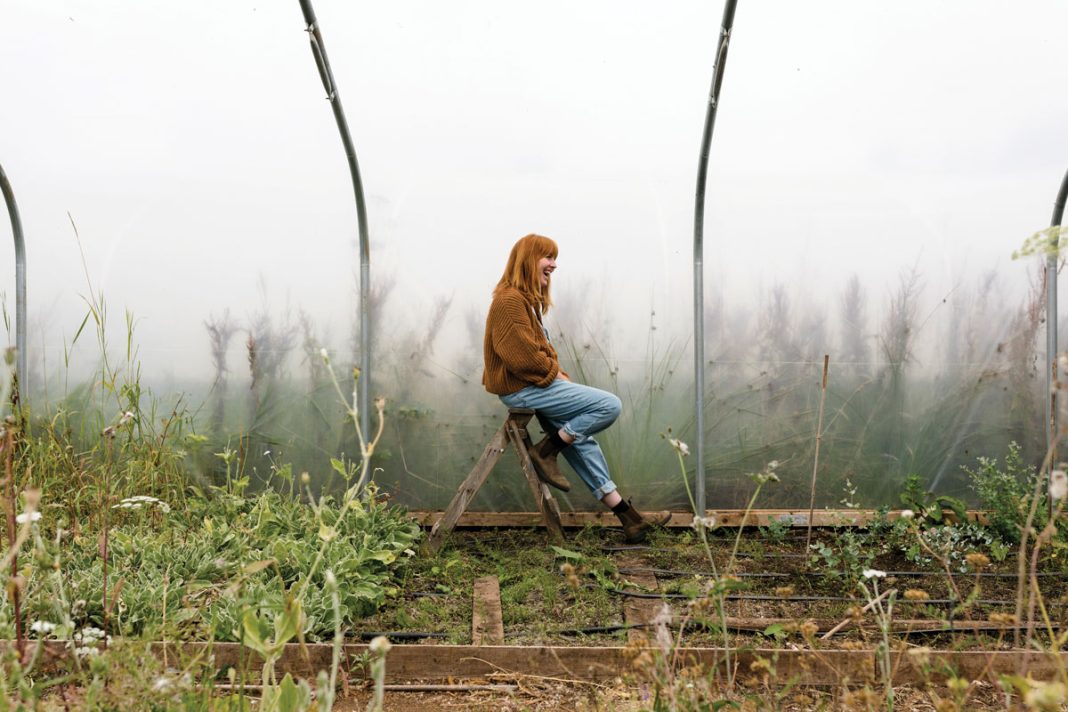We spoke to Fiona Inglis, owner of floral studio Pyrus Botanicals and an incredible Victorian walled garden just outside of Edinburgh
interview Miriam Methuen-Jones
Fiona owns Pyrus Botanicals, a studio supplying plants and florals to weddings and the Scottish wholesale market. Her team also creates installations and collaborates with perfumers, artists, and local businesses like Bard. We ask Fiona how flowers became her career.
What came before Pyrus?
After finishing art college in Edinburgh, I took a few different part-time jobs. One was in a really beautiful flower shop. I’d always been inspired by nature, some of my work in art college had tied in with nature, but it was really working in the flower shop that I fell in love with flowers.
For somebody who has a fairly short attention span and is maybe a little fickle, the ever-changing medium of flowers was very attractive to me.
Having different materials to work with week to week or month to month and creating things that are instant – I very much enjoyed that and was bitten by the bug.
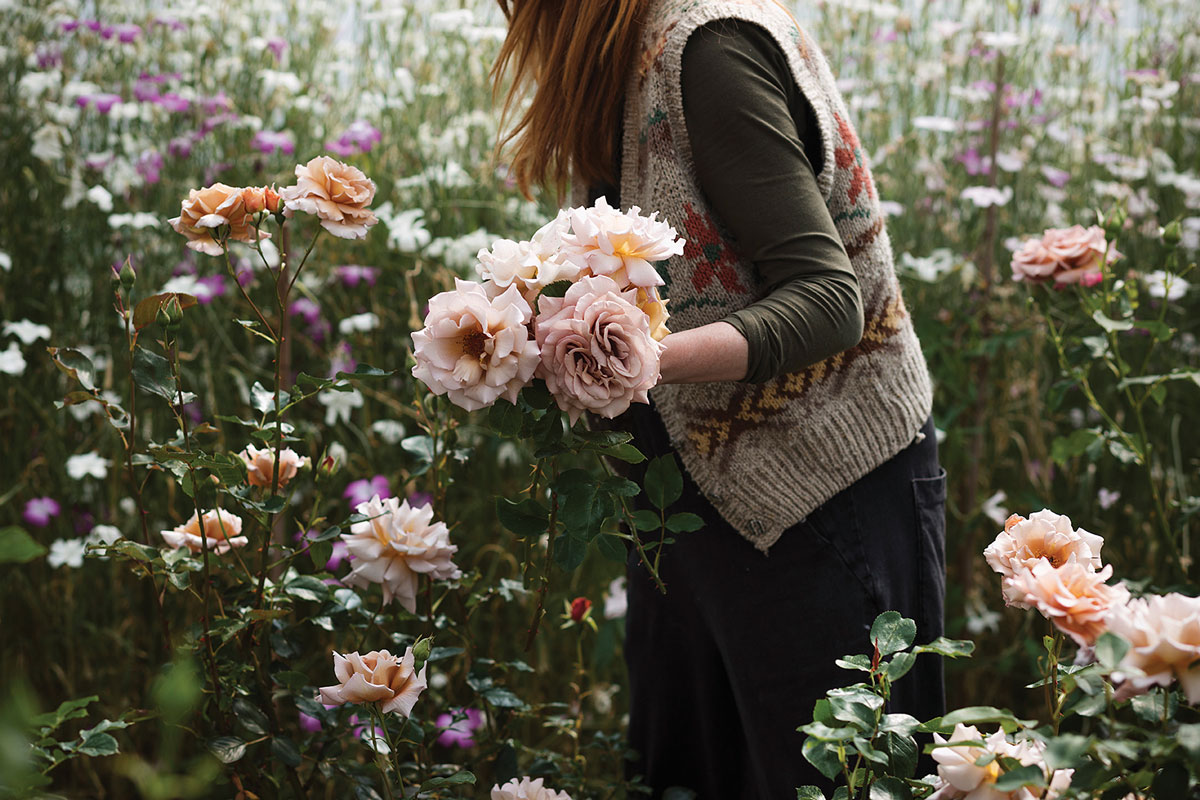
Why choose flowers?
I think floral design is very similar to poetry; when you’re communicating through flowers, there’s a certain level that says something more than words, or says things that I find quite difficult to put into words.
I think that’s also why I enjoy working with perfumists and scent, because again it’s very evocative and emotive. It takes you somewhere. It says things that are more complex than just our usual form of communication.
Flowers also say something in themselves. They set the tone and the atmosphere. It’s important for us to understand what’s important to our client and what they want to express in a feeling, rather than how they want it to look.
Why did you decide to grow your own flowers?
There was a local grower (Mr Smith, he’s a bit of a legend in Edinburgh) who owned a market garden. He just grew a couple of crops of flowers, one of which was garden roses. They would be delivered to the flower shop I worked in, humbly wrapped in newspaper. They were incredibly scented and incredibly beautiful, we had a long waiting list of customers wanting Mr Smith’s roses.
Compared to these flowers, the roses we were getting from Holland were starkly different. In Holland, quite often they’ll breed the scent out of a flower so that it has a longer shelf life. To me that just seemed so crazy. One of the amazing qualities of a flower is its scent!
An opportunity came up for me to work on an organic farm in Fife. The farm grew a small section of flowers along with the veg. That’s where I began to learn how to grow flowers.
Because I came from a floristry background, I started to dabble in doing weddings using local flowers. People were really interested, and I recognised there was a gap in the market there.
The style and aesthetic for flowers was changing – people were looking for something more natural. It was at that point that I realised I couldn’t get my hands on the flowers I wanted.
So I just thought, I’ll grow my own…
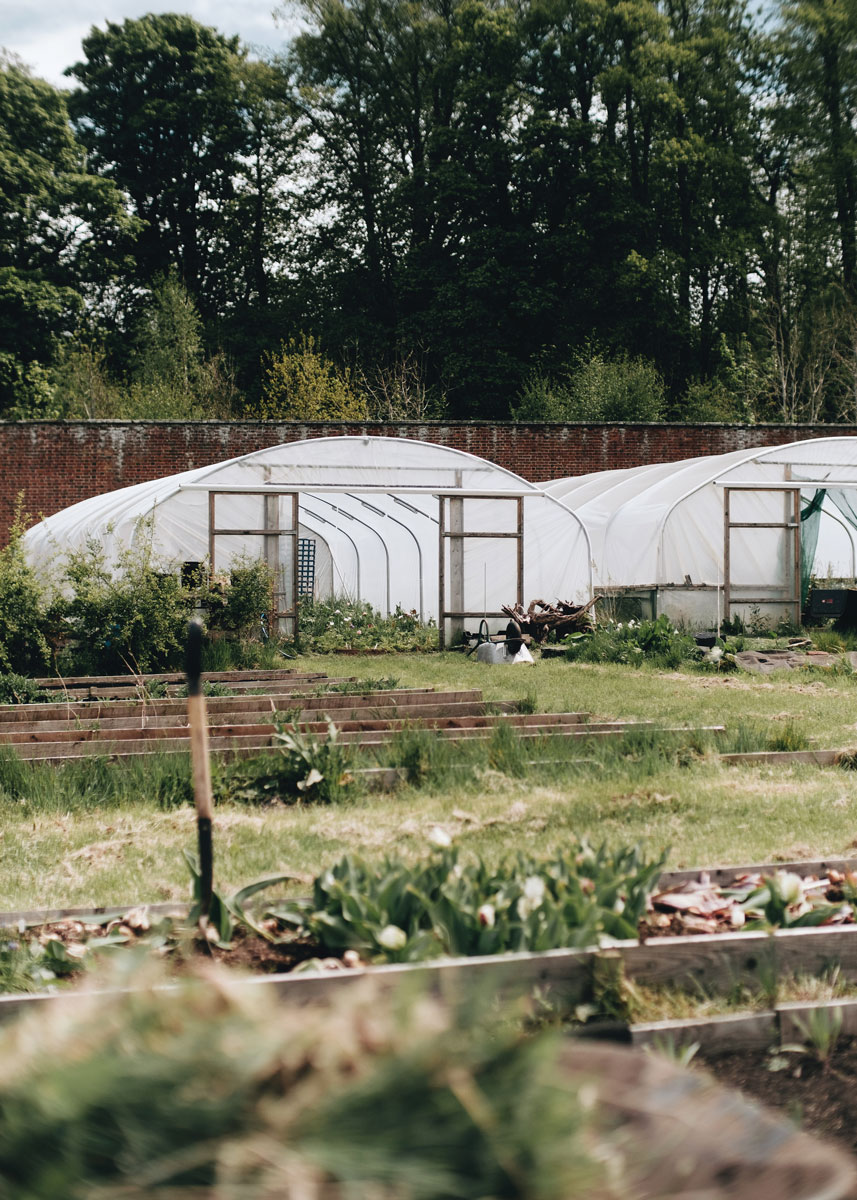
Did you immediately fly solo?
When we set up in 2011 it was me and Natalya Ayers, my business partner at the time. We’d worked in flower shops together and had very similar ideas about what we wanted to do and how we wanted to work.
In 2020 Natalya and her partner decided to move to Italy. They’ve moved to the mountains and are renovating a shepherd’s hut and learning about permaculture. So now it’s just myself running the business. In the summer I have a team of five: a florist in the studio, a gardener, harvester, and part-time driver.
So, a walled garden. That must have been quite the undertaking.
Enthusiasm filled with naivety takes you to the point where you go ‘Yeah I’m going to take on this walled garden and grow all my own flowers’. It wasn’t an easy journey. I hadn’t had any formal horticultural training, just a few years growing on the farm.
I hadn’t even had my own garden before – I’d helped my parents a bit when I was younger, but didn’t have any proper prior knowledge.
It was very much learning on the job. For me that’s the best way to learn, I have to experience something to actually understand it. It was a lot of trial and error. But despite the lack of formal training, I think gardening is often like that.
What might work for one person in one scenario is not necessarily going to work for you in your scenario.

What condition was the garden in when you took it on?
It had been empty for quite a few years and was full of waist-high weeds. The last custodian had tried to make it into a market garden and had left quite a few years earlier. When we took it on, very enthusiastically, we started doing things and then had to learn and figure it all out.
It’s a big garden but it was designed for a horse and cart, so you can’t get a tractor into the garden, the gate in is too small. We managed to find a local chap who was a tractor collector who had a couple of vintage tractors; he came in and ploughed it for us with this old tractor that honestly looked like something out of Thomas the Tank Engine!
It wasn’t until it was all flattened and bare that we really saw how big the space was. The main issue was the weeds – generation upon generation of weeds in there.
What did the revitalisation process look like?
We needed to deal with the weeds first, so planted the whole area with grass seed and clover to create bit of competition. Half the garden we treated like that, cut the grass and cut the weeds down regularly to manage the space.
The other half we’ve took a section at a time. We put infrastructure in, put some beds in, added a polytunnel every couple of years. It was all about building it up slowly and methodically.
The previous custodian planted a little orchard, so we’ve got lovely apple and pear trees – it’s amazing, it feels like such a gift from the garden. On the other side of the garden there’s a pocket of trees, a little woodland area.
It’s a patient person’s game, and I’m not a naturally patient person so this has been such an amazing learning journey. You have to tune into the pace of the plants and take the long-term view.
Put in the plants that take a bit longer to establish in the beginning. We didn’t do that – it was maybe year three or four when we put in the shrubs and the perennials, the things that take a bit longer to establish.
You can’t help but think ‘If only I’d done that right in the beginning’!
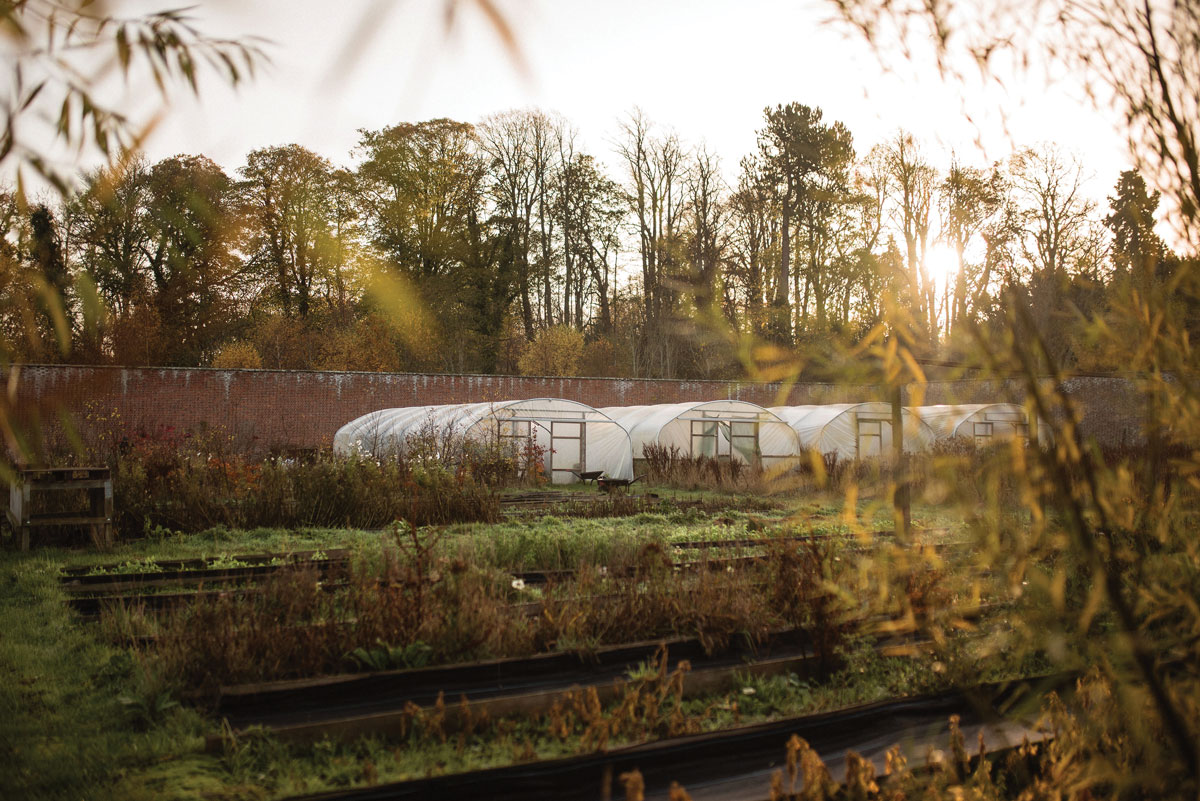
How ‘green’ is the garden?
The environmental aspects are really important to us, that’s been the case from the beginning. We don’t use any chemicals, and we garden as naturally and gently as possibly. Lots of the no dog technique, lots of companion planting and green manures.
We do a lot of mulching because we have such a big space and so many weeds. It’s not practical for us to dig out metres and metres of weeds so we use event carpet (a waste product which event companies have to dispose of after it’s been used to line a marquee or stage) and cover large areas of the ground.
Leave it for a couple of years and that kills the weeds underneath it and creates mulch.
The perimeter of the garden is also left quite wild and overgrown, we do that to encourage biodiversity and provide environments for natural predators.
As humans we have this urge to control everything but it doesn’t actually need us to do that. If you let the garden do its thing, it’ll look after itself. For example, we grow a lot of beautiful ranunculus and bulbs which are delicious for mice and voles – I do have to set some traps in winter.
One winter I realised I wasn’t catching anything, I thought the mice had worked out the traps, but I wasn’t seeing any damage to the bulbs. Then we spotted this stoat skulking around and realised we had a stoat family move in!
They manage the mouse population. It’s a balance.
Now that the garden is established, what’s on your plate?
I’m learning more about permaculture and bringing in some of those principles. The next thing on my wish list is a pond. I feel like a pond will solve all my woes. I love frogs!
2023 for me was all about focusing on the wholesale element of the flowers and making that more accessible. There’s still lots of people who aren’t aware that you can get good quality local flowers.
In the time that we’ve been operating there’s a much greater demand for local flowers. It’s something that we see more and more of each year. The emissions and carbon produced from the level of imports currently used is phenomenal.
There are reports showing some scary comparisons: a one way flight from Paris to London is about 60kg of CO2 per passenger and one bouquet of standard imported flowers is about 30kg.
Think about how many bouquets you buy in your life and how that stacks up. It’s staggering. It’s important that there’s an alternative.
If people want something different, it’s important that they have access to it. We’re opening up to a wider customer base to encourage this.
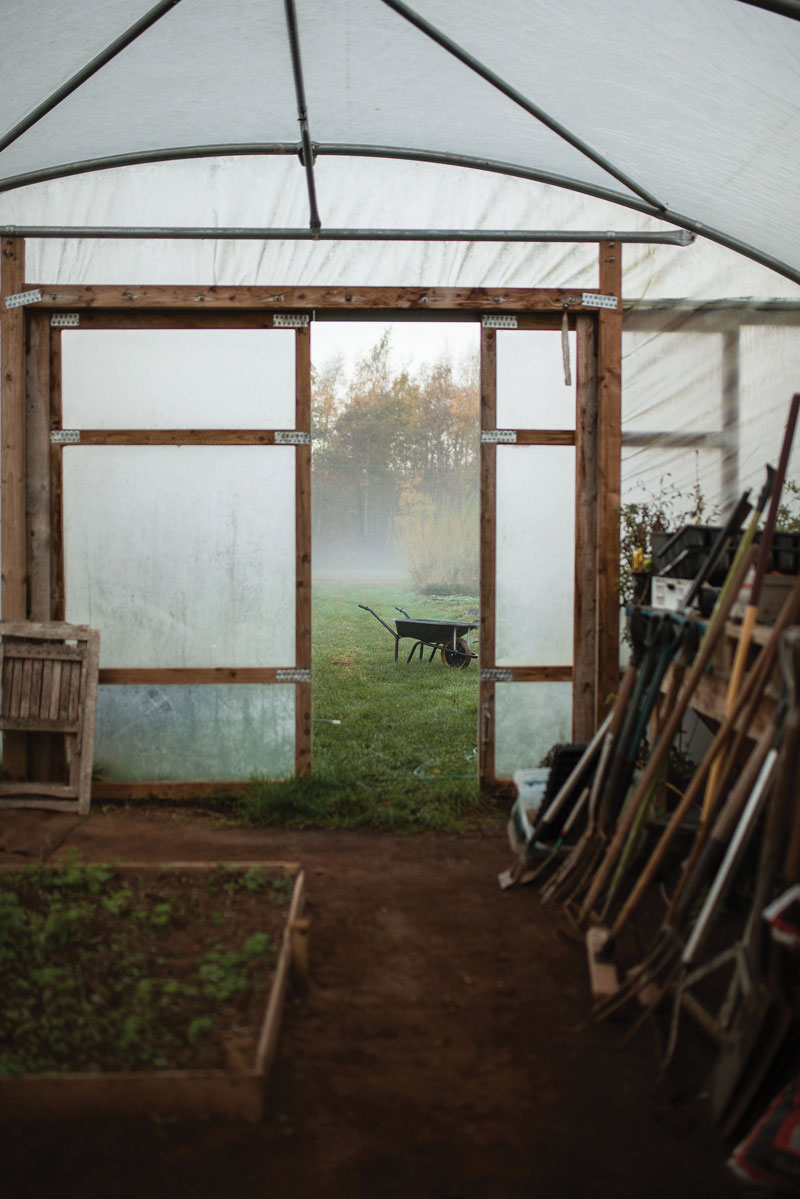
This all sounds very positive, how are you achieving this?
We’ve been working with local flower shops and markets, as well as teaming up with the big companies and Dutch companies that are keen to provide an avenue for local flowers.
We’ve also been working with Scottish Enterprise for the last few years – working on how to improve the infrastructure and distribution, putting all the dots together. When we started there was about six Scottish flower growers and now there are about 70.
That’s a massive boom. There are lots of micro-growers like us and a lot of big farms starting to diversify but everyone is working individually. We’re looking to find ways to link everyone together to work as one network.
We’ve established the Scottish Flower Grower Collective and there’s another association called Flowers Grown in Scotland working on networking and distribution.
At Pyrus we do a lot of big weddings, and we’ll be able to get most of the flowers from our garden but we may need to top up. At the moment, I need to contact six different growers individually to find out what kind of flowers they have and then put in an order with each individually and then work out how to physically get them all.
We’re working on an online buying platform. Local flowers need to be much easier to source.
What do you wish more people were aware of?
We have to do something! I bet a lot of people feel like that. Our environmental efforts feel so minuscule in the grand scheme of things, but I think there’s a lot that needs to happen around educating people and big companies especially.
There are lots of small changes that could start to create a bigger effect. There’s so little understanding around the energy and resources involved in producing plants, they’re often seen as disposable items.
Even when COP26 happened in Glasgow there was a clear lack of knowledge around where the products for the designs would be coming from.
The orchids and thistles would be travelling all the way across the world to get to you instead of opting for something seasonal and of the landscape instead… It just takes time, doesn’t it, for learning and change to happen.

Finally, any advice for gardening in these colder months?
The beginning of the year is the time where I think we should be able to clock out. Traditionally we would be fairly deep into the hibernation stage – as people, we feel that.
Everyone I speak to is more tired than normal. I think at this point in the year you should do what you feel like doing. Our work in spring, summer, and autumn is pretty relentless (the flowers don’t stop growing and you have to be on it!) so January and February is our time to take a breather.
For a few weeks I’ll put the auto-response on the emails, I’ll read that book. It’s only in that time that I’m able to process everything that’s happened in the previous year and be able to see what went well, what didn’t and what I want to do more of.
I think humans need that, we need space to go ‘Am I okay? Is everything I’m doing here okay?’
Slow down. But also, if you feel inspired to do things on those lovely crisp winter days then don’t ignore it. Quite often on those bright, sharp days you’ll find me in my greenhouse having a good clear out and tidy up.
But I very much of that on the basis of if I’m inspired, rather than feeling that I have to.
I’m always conscious to take it slower in those deeper parts of winter. Spring will come back soon enough.


